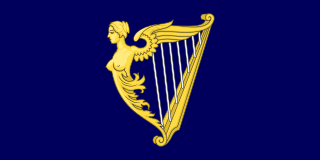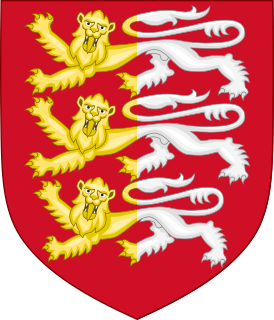Related Research Articles

The Kingdom of Ireland was a monarchy on the island of Ireland that was a client state of the Kingdom of England and then of Great Britain. It existed from 1542 until 1800. It was ruled by the monarchs of England and then the monarchs of Great Britain. The kingdom was administered from Dublin Castle by a viceroy appointed by the English king — the Lord Deputy of Ireland. A Parliament of Ireland, composed of Anglo-Irish and native nobles, was created. From 1661-1801, the administration controlled an army. A Protestant state church — the Church of Ireland — was established. Although styled a kingdom, for most of its history it was, de facto, an English dependency. This status was enshrined in Poynings' Law and in the Declaratory Act of 1719.

Hugh O'Neill, was an Irish Gaelic lord, Earl of Tyrone and was later created The Ó Néill Mór, Chief of the Name. O'Neill's career was played out against the background of the Tudor conquest of Ireland, and he is best known for leading a coalition of Irish clans during the Nine Years' War, the strongest threat to the House of Tudor in Ireland since the uprising of Silken Thomas against King Henry VIII.

The Plantation of Ulster was the organised colonisation (plantation) of Ulster – a province of Ireland – by people from Great Britain during the reign of King James I. Most of the settlers came from southern Scotland and northern England; their culture differed from that of the native Irish. Small privately funded plantations by wealthy landowners began in 1606, while the official plantation began in 1609. Most of the colonised land had been confiscated from the native Gaelic chiefs, several of whom had fled Ireland for mainland Europe in 1607 following the Nine Years' War against English rule. The official plantation comprised an estimated half a million acres (2,000 km2) of arable land in counties Armagh, Cavan, Fermanagh, Tyrone, Donegal, and Londonderry. Land in counties Antrim, Down, and Monaghan was privately colonised with the king's support.

The Irish Rebellion of 1641 was an uprising by Irish Catholics in the Kingdom of Ireland, who wanted an end to anti-Catholic discrimination, greater Irish self-governance, and to partially or fully reverse the plantations of Ireland. They also wanted to prevent a possible invasion or takeover by anti-Catholic English Parliamentarians and Scottish Covenanters, who were defying the king, Charles I. It began as an attempted coup d'état by Catholic gentry and military officers, who tried to seize control of the English administration in Ireland. However, it developed into a widespread rebellion and ethnic conflict with English and Scottish Protestant settlers, leading to Scottish military intervention. The rebels eventually founded the Irish Catholic Confederacy.

The Tudor conquestof Ireland took place under the Tudor dynasty, which held the Kingdom of England during the 16th century. Following a failed rebellion against the crown by Silken Thomas, the Earl of Kildare, in the 1530s, Henry VIII was declared King of Ireland in 1542 by statute of the Parliament of Ireland, with the aim of restoring such central authority as had been lost throughout the country during the previous two centuries. Several people who helped establish the Plantations of Ireland also played a part later in the early colonisation of North America, particularly a group known as the West Country men.

Plantations in 16th- and 17th-century Kingdom of Ireland involved the confiscation of Irish-owned land by the English Crown and the colonisation of this land with settlers from Great Britain. The Crown saw the plantations as a means of controlling, anglicising and 'civilising' parts of Ireland. The main plantations took place from the 1550s to the 1620s, the biggest of which was the plantation of Ulster. The plantations led to the founding of many towns, demographic and economic changes, changes in land ownership and the landscape, and also to ethnic and sectarian conflict. They took place before and during the earliest English colonisation of the Americas, and a group known as the West Country Men were involved in both Irish and American colonization.

From the 12th century onwards, a group of Normans invaded and settled in Gaelic Ireland. These settlers later became known as Norman Irish or Hiberno-Normans. They originated mainly among Cambro-Norman families in Wales and Anglo-Normans from England, who were loyal to the Kingdom of England, and the English state supported their claims to territory in the various realms then comprising Ireland. During the High Middle Ages and Late Middle Ages the Hiberno-Normans constituted a feudal aristocracy and merchant oligarchy, known as the Lordship of Ireland. In Ireland, the Normans were also closely associated with the Gregorian Reform of the Catholic Church in Ireland. Over time the descendants of the 12th-century Norman settlers spread throughout Ireland and around the world, as part of the Irish diaspora; they ceased, in most cases, to identify as Norman, Cambro-Norman or Anglo-Norman.

Ireland during the period 1536–1691 saw the first full conquest of the island by England and its colonization with mostly Protestant settlers from Great Britain. This would eventually establish two central themes in future Irish history: subordination of the country to London-based governments and sectarian animosity between Catholics and Protestants. The period saw Irish society outside of the Pale transform from a locally driven, intertribal, clan-based Gaelic structure to a centralised, monarchical, state-governed society, similar to those found elsewhere in Europe. The period is bounded by the dates 1536, when King Henry VIII deposed the FitzGerald dynasty as Lords Deputies of Ireland, and 1691, when the Catholic Jacobites surrendered at Limerick, thus confirming Protestant dominance in Ireland. This is sometimes called the early modern period.

Sir James Ware was an Irish historian.
Kenneth W. Nicholls, Irish academic and historian, is a widely respected Irish historian.
The Portadown massacre took place in November 1641 at Portadown, County Armagh, during the Irish Rebellion of 1641. Irish Catholic rebels, likely under the command of Toole McCann, killed about 100 Ulster Protestants by forcing them off the bridge into the River Bann, and shooting those who tried to swim to safety. The Protestant settlers were being marched east from a prison camp at Loughgall. This was the biggest massacre of Protestants during the rebellion, and one of the bloodiest during the Irish Confederate Wars. The Portadown massacre, and others like it, terrified Protestants in Ireland and Great Britain, and were used to justify the Cromwellian conquest of Ireland and later to lobby against Catholic rights.

Atlantic history is a specialty field in history that studies the Atlantic World in the early modern period. The Atlantic World was created by the discovery of a new land by Europeans, and Atlantic History is the study of that world. It is premised on the idea that, following the rise of sustained European contact with the New World in the 16th century, the continents that bordered the Atlantic Ocean—the Americas, Europe, and Africa—constituted a regional system or common sphere of economic and cultural exchange that can be studied as a totality.

The first evidence of human presence in Ireland dates to around 33,000 years ago, with further findings dating the presence of homo sapiens to around 10,500 to 7,000 BC. The receding of the ice after the Younger Dryas cold phase of the Quaternary around 9700 BC, heralds the beginning of Prehistoric Ireland, which includes the archaeological periods known as the Mesolithic, the Neolithic from about 4000 BC and the Copper Age beginning around 2500 BC with the arrival of the Beaker Culture. The Irish Bronze Age proper begins around 2000 BC and ends with the arrival of the Iron Age of the Celtic Hallstatt culture, beginning about 600 BC. The subsequent La Tène culture brought new styles and practices by 300 BC.
Alexander MacDonnell, 3rd Earl of AntrimPC (Ire) (1615–1699) was a Catholic peer and military commander in Ireland. He fought together with his brother Randal on the losing side in the Irish Confederate Wars (1641–1653); and then, having succeeded his brother as the 3rd Earl of Antrim in 1683, fought in the Williamite War (1688–1691), on the losing side again. Twice he forfeited his lands and twice he regained them.

Connor O'Brien, 2nd Viscount Clare (1605–1670) was the son of Daniel O'Brien, 1st Viscount Clare and Lady Catherine FitzGerald, a daughter of Gerald, 14th Earl of Desmond.
The Irish Historical Research Prize is a history book prize awarded biannually since 1922 by the National University of Ireland (NUI) to a senior historian for the best new work of research on any period in the history of Ireland. It is considered the most prestigious prize in the study of Irish history.

The Laggan Army, sometimes referred to as Lagan Army, was a militia formed by Protestant settlers in the fertile Laggan Valley of County Donegal, Ulster, during the time of the Irish Rebellion of 1641.
John Bradley was a historian and archaeologist at NUI Maynooth. He grew up in Kilkenny and published many papers about his hometown.
Maurice Roche, 8th Viscount Fermoy (1593–1670) was an magnate and soldier in southern Ireland, and a politician of the Irish Catholic Confederation. He joined the rebels in the Irish Rebellion of 1641 in January 1642, early for Munster, by besieging Richard Boyle, 1st Earl of Cork, a Protestant, in Youghal. He fought for the Confederates in the Irish Confederate Wars and sat on three of their Supreme Councils. He fought against the Parliamentarians in the Cromwellian conquest of Ireland and was excluded from pardon at the surrender in 1652. At the restoration of the monarchy in 1660 he recovered his title but not his lands.
References
- 1 2 "Professor Nicholas Canny". National University of Ireland, Galway. Retrieved 15 November 2010.
- ↑ "Humanities - NUI Galway". www.nuigalway.ie. Retrieved 17 April 2019.
- ↑ "Professor Nicholas Canny". The British Academy. Retrieved 17 April 2019.
- ↑ "APS Member History". search.amphilsoc.org. Retrieved 10 May 2021.
- Maher, Helen; Galway Authors, 1976